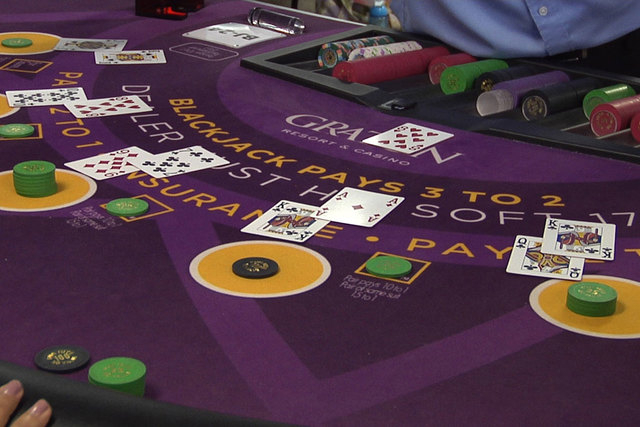California tribal gaming market regains momentum

Eight years ago, California’s Indian casino market was approaching $8 billion in annual gaming revenue. By comparison, Nevada casinos in 2007 brought in a single-year record $12.8 billion, of which $6.8 billion came from the Strip.
The recession knocked the California casino market down a few notches, as it did in Nevada.
But the Golden State’s tribal gaming industry is firing up again.
California’s 69 Indian casinos produced slightly less than $7 billion in gaming revenue in 2013 — $6.994 billion to be exact — according to the recently released Indian Gaming Industry Report for Casino City, authored by California economist Alan Meister.
The state’s casinos accounted for a fourth of the nation’s $28.3 billion in total Indian gaming revenue in 2013.
Meister, who has written the annual Indian gaming report for 13 years, didn’t downplay California’s importance.
“The state can spur growth for the whole Indian gaming industry,” he said.
It’s still hard to predict when or if California will surpass the $7.8 billion revenue figure Indian casinos collected in 2007. However, there are enough projects on paper or coming out of the ground to cause the investment community to take notice.
Meister detailed almost 30 gaming and casino hospitality developments moving forward in California, everything from new hotel towers, additional entertainment features and expanded gaming space.
More than a dozen tribes have land-in-trust applications pending, awaiting federal reviews on their potential gaming sites or are negotiating compacts with the state.
“These different issues, such as land-in-trust applications, take awhile to play out,” Meister said.
Station Casinos and the Federated Indians of Graton Rancheria can write the book on waiting. The Las Vegas-based gaming company and the Sonoma County Indian tribe spent more than a decade gaining approvals and planning before opening the $800 million Graton Resort & Casino in November 2013.
The casino contributed a little less than two months of operations to California’s 2013 total.
Meister said his publication of the 2014 results next year will give folks an idea if Graton has grown the market or is simply taking business away from rival Indian casinos, such as River Rock or Cache Creek.
“My guess is that it will be a little bit of both,” Meister said of Graton, which Station Casinos built for the tribe and is managing under a seven-year contract.
Fitch Ratings Service gaming analyst Alex Bumazhny told the Santa Rosa Press-Democrat that he suspects Graton “grew the market substantially” but also took business from some of the casinos operating near Sacramento.
Graton, near Highway 101 in Rohnert Park, is 48 miles north of San Francisco and heavily markets to the Northern California city and the surrounding area.
When it reported its 2014 first-quarter results, Station Casinos said the initial numbers for Graton were $101 million in revenue and $57 million in cash flow in just three months.
That news prompted Credit Suisse gaming analyst Joel Simkins to call the resort one of the most profitable and highest-margin regional casinos around.
“Given an easily accessible location and deep feeder markets, Graton has put up big numbers out of the box,” Simkins said at the time.
Graton does not have a hotel, although the location is slated for a 200-room hotel in the future and was one of the amenities Meister cited in his report. He called nongaming expansion projects “a theme throughout Indian gaming.”
Penn National Gaming is taking notes on Graton’s success.
The regional gaming operator — which owns M Resort in Henderson — is building the $360 million Hollywood Casino Jamul, 20 miles east of San Diego for the Jamul Indian Village. Penn will operate the casino under a management contract. The company said it expects to open the resort in 2016.
Analysts said cash flow returns from the project could reach the 20 percent range because of the low tax rate under the gaming compact the tribe signed with California in 1999.
Penn National CEO Tim Wilmott said in January that the company will receive “management and branding fees, as well as interest payments on funds advanced to develop the project.”
The Jamul project is the only major casino development underway in California.
According to Meister’s report, California had 70,193 slot machines and 2,008 table games in 2013, the most in the nation for any category. Jamul will add another 1,700 slot machines and 50 table games next year.
Station Casinos has one other potential California Indian casino project through development and management agreements with the North Fork Rancheria of Mono Indians. The company would build and operate a casino in central California, about 25 miles north of Fresno.
However, California voters shot down the casino in November’s election. The tribe filed a lawsuit last month to keep the development alive. Meister hinted a smaller facility with slot machinelike video lottery terminals might serve as a compromise.
Several large California tribal casinos have new compacts that would let them increase their slot machine and table gaming totals. The recession kept the new games from heading onto the casino floors.
Meister said improvements in the economy could allow some of the proposed expansion projects to come to fruition.
“We’ll see some more positive growth in the next few years,” Meister said.
Programming note: Inside Gaming will be on hiatus for a few weeks while I take some time off. The column will resume its regular schedule May 13.
Howard Stutz’s Inside Gaming column appears Wednesdays and Sundays. He can be reached at hstutz@reviewjournal.com or 702-477-3871. Find him on Twitter: @howardstutz.












